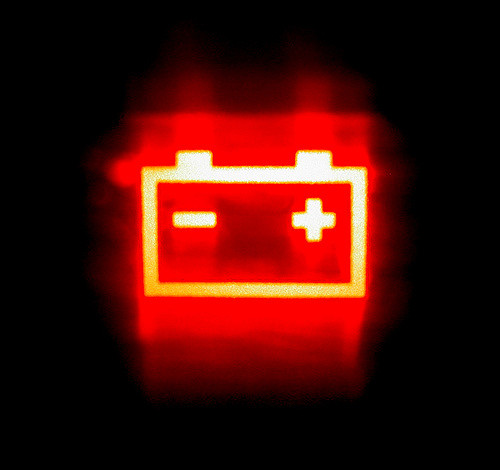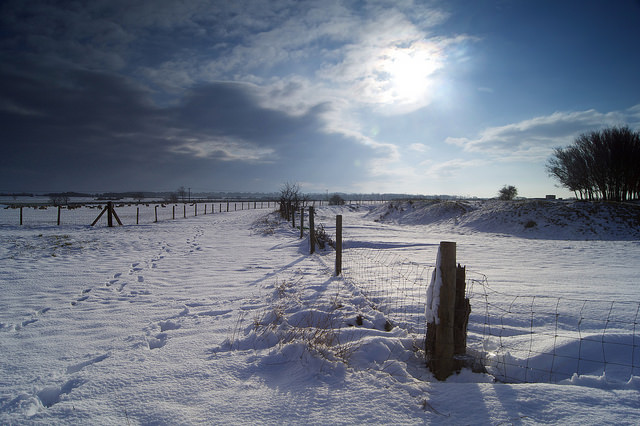You’re driving out in the middle of nowhere.
Well, it’s not nowhere per se. More like out on the periphery. You’re on the frontier, the edge of society, the far reaches of civilization.
Sure, you might have just started from town this morning, but with those snow-covered mountains and high-reaching trees all around, you know you’re in the wilderness.
The only tether you have to the real world is the road you’re on … and your vehicle. Maybe it’s a 4-wheel-drive truck. Perhaps it’s a compact car. Either way, she’s running, and she’s running good.
Whiz…boom…pop! Oops – what’s that?
Oh, no … you’ve lost power. Steering is locking up and becoming sluggish, the gas doesn’t work.
Slowly, oh so slowly, your car creeps to a stop. The only sound is the music list you’d keyed up for this trip.
It’s loud, blaring really, you notice for the first time. You reach over to switch it off.
That’s when it hits you: silence. You really are alone out here. What do you do?

Low Battery Warning Indicator © Andy Armstrong (Flickr)
The First 10 Minutes
Your car has died, and you’re in the middle of nowhere…or close enough. The good news is that the car isn’t completely dead – the battery still works.
The average car battery will run for 12 hours or more if you’re not using a lot of features, like the stereo, the overhead light, or the heater.
If you have a full tank of gas you can run the engine to keep the battery charged. That gas will last you about 24 hours at most, however. You’re probably not thinking this as you start looking around your vehicle.
You frown and switch off the battery and open the door. Your boot crunches on snow as you get out of the vehicle. Your eyes hurt from all the white around, the snow blindness that comes in.
Putting your hand to your forehead, you start toward the hood. Getting it open you stare into the engine.
It looks fine. You wiggle a few wires. It still looks fine. You close the hood and walk back to the back of the vehicle, either the trunk or the storage area of your SUV. Opening it up, you frown.
There before you is a 2-year-old can of bug spray, a frozen bottle of water from last summer…and not much else.
Sighing, you close her up and look down the road. It’s empty, no cars in sight. You didn’t expect much, not heading out this way.
You walk off the road a bit … and immediately sink a few feet in the deeper snow. With another frown you walk back to your car, get inside.
The First Hour
In December 2011, ABC News had a story about David Higgins, his wife Yvonne, and their 5-year-old little girl.
They’d been driving in northern New Mexico on a ski trip when the weather turned. David couldn’t see, pulled over, and the SUV got snowed-in.
Despite having plenty of food and water, the family was “lethargic” and growing weak when rescuers found them two days later. The key here for the Higgins family was that they had ample food and water.
Do you have that? Chances are good you have a bottle of soda and maybe some snacks from the gas station. That’s just not going to cut it.
If you do think you’ll be stranded for awhile, consider getting out and gathering some snow to bring into the vehicle. It’ll melt, and you’ll have water.
Remember, if you go three to four days without water, you’ll die.
The Next 3 Hours, or 6 … or 12
Something you might not want to think about this early is the bathroom.
You’ll have to go sometime and cordoning off an area outside your vehicle for that is a good idea.
Remember, if the snow is blowing heavy, you’ll want a clear area of movement outside your vehicle. At the least you need to keep the door clear of snow drifts so you can open it.
Stranded highway motorists have had problems with bathrooms before. In March 2015 in Kentucky, a massive snowstorm hit that kept motorists stuck on the highway for 12 hours.
People had no food, no water, and no bathroom. They could use their phones, and they called and tweeted their dilemma.
Rescuers, however, could not reach them. So be prepared, as that first hour could stretch into several, or possibly even days.
Could you survive? Chances are you can if you have the basics – food, water, and adequate shelter.
Always have a full tank of gas when travelling in the winter. Make sure your car battery is not older than four years.
If you can’t keep food in the car because you’ll eat it, put in some dog biscuits. You won’t eat those unless you have to.
Small things like that can save your life. Be prepared and be thankful — disaster can hit at anytime.
